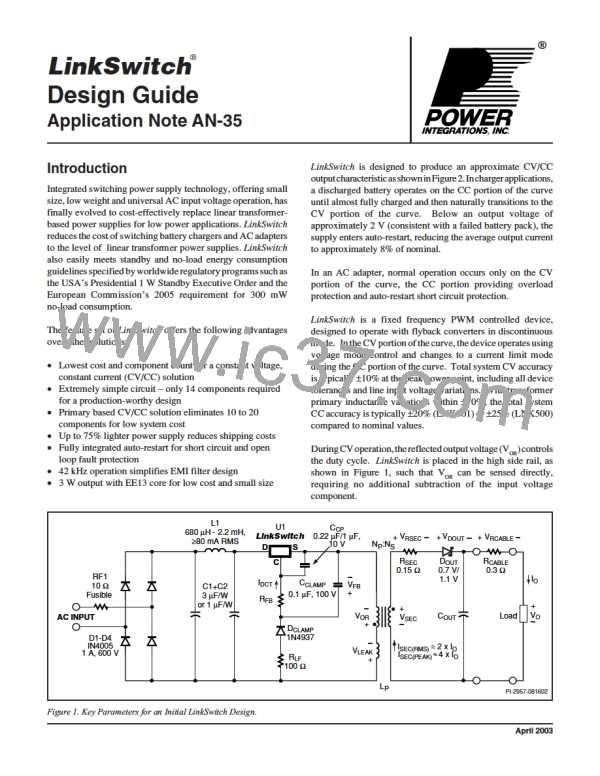AN-35
• Output diode forward voltage - VDOUT
Any change in the current through RFB, due to the tolerance of
the CONTROL pin current at 30% duty cycle, IDCT, will also
cause a change in the output voltage. The change in the voltage
across RFB (kΩ) due to the tolerance of IDCT (mA) is given by:
• Current variation through RFB due to CONTROL pin
voltage tolerance at 30% Duty Cycle (IDCT
• Feedback resistor tolerance - ∆%RFB
)
IDCT(MAX) − IDCT(MIN)
Each of the key parameters above is examined in turn.
∆VRFB(IDCT)
=
× RFB (A5)
2
The most significant variation in the output voltage is the
change with input line.
Expressed as a percentage of the voltage across VFB, the
variation is:
The voltage across RFB is defined at IDCT, corresponding to a
30% duty cycle at low line voltage. At higher line voltage, the
CONTROL pin current increases and the voltage across RFB
increases. ThechangeinvoltageacrossRFB, ∆VFB(LINE), depends
on the change in duty cycle ∆DC, the corresponding change in
CONTROL pin current ∆IC (mA) and the value RFB (kΩ). The
change in CONTROL pin current for a given change in duty
cycle can be found from a curve in the LinkSwitch data sheet.
∆VRFB(IDCT)
(A6)
∆%IDCT
=
×100%
VFB
Theoverallvariationcanthenbeestimatedusingtheexpression:
∆%CV = ∆%LINE ∆%VDOUT
∆%V2C(IDCT)
+
(A7)
∆%2IDCT + ∆%2RFB
Using the design shown in Figure 3 as an example:
6 V − 5.75 V
∆VRFB(LINE) = ∆IC × RFB
(A1)
For a universal input voltage design, ∆DC from low line to high
line is typically 0.2 (0.09 for a single input design) giving a
change in CONTROL pin current of typically 0.15 mA.
∆%VC(IDCT)
=
×100% = 0.46%
54.2 V
The value of ∆VRFB(LINE) should be expressed as a percentage of
VFB to give the variation at the power supply output. The
expression for line variation (at the peak power point) is
therefore:
(A8)
0.025 V
∆%VDOUT
=
×100% = 0.23%
2 × 5.5 V
∆VRFB(LINE)
2 × VFB
(A9)
(A2)
∆%LINE
=
×100%
∆VRFB(LINE) = 0.15 mA × 20.5 kΩ = 3.1 V
(A10)
The CONTROL pin voltage VC(IDCT) is specified at a current
equal to IDCT,giving a duty cycle of 30% for a typical design at
the peak power point, at 85 VAC input. The tolerance of this
parameter includes temperature variation and can be read from
the data sheet directly. Since the output voltage is actually
controlled using VFB, the variation of VC(IDCT) must be expressed
as a percentage of VFB. The expression for this is given by:
3.1 V
∆%LINE
=
×100% = 2.9%
2 × 54.2 V
(A11)
2.36 mA − 2.24 mA
∆VRFB(IDCT)
=
× 20.5 kΩ
2
(A12)
= 1.23 V
VC(IDCT)(MAX) − VC(IDCT)(TYP)
∆%VC(IDCT)
=
×100%
VFB
1.23 V
=
(A3)
(A13)
∆%IDCT
×100% = 2.27%
54.2 V
Anyvariationintheoutputdiodeforwarddropwithtemperature
will cause a change in the output voltage. Expressing as a
percentage of VO gives the expression:
The tolerance of R1 (RFB) is 1%.
∆VDOUT
2 × VO
(A4)
∆%VDOUT
=
×100%
∆%CV = 2.9% 0.23%
(0.462 + 2.272 +12 )
= 2.9% 0.23% 2.52%
= 5.65%
Typicalvaluesforthechangeinforwardvoltageforatemperature
change of +50 °C are +0.1 V for a silicon PN diode
and +0.025 V for Schottky diode. For device-to-device
variations, please consult diode manufacturer.
(A14)
B
4/03
13

 ETC [ ETC ]
ETC [ ETC ]